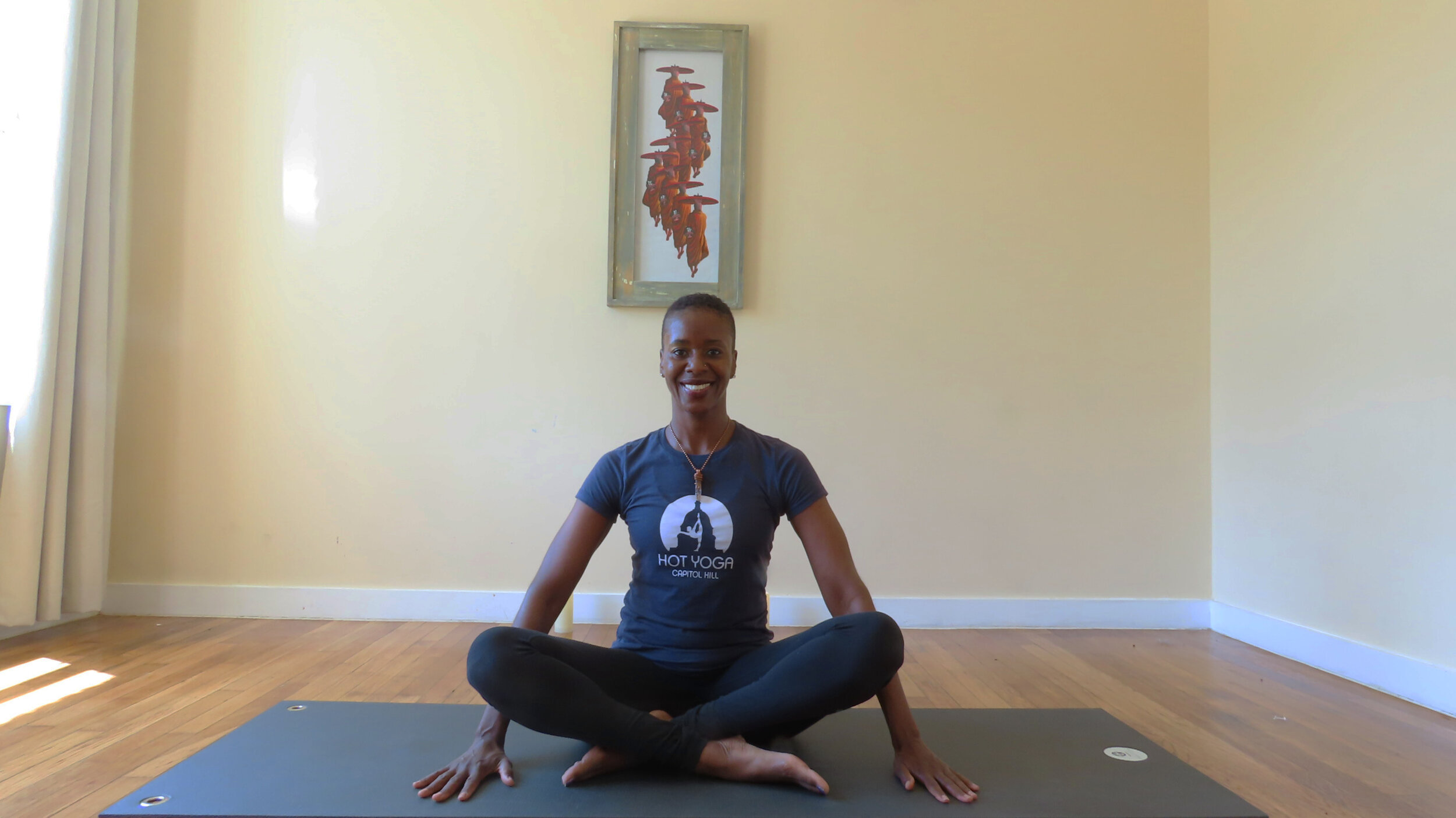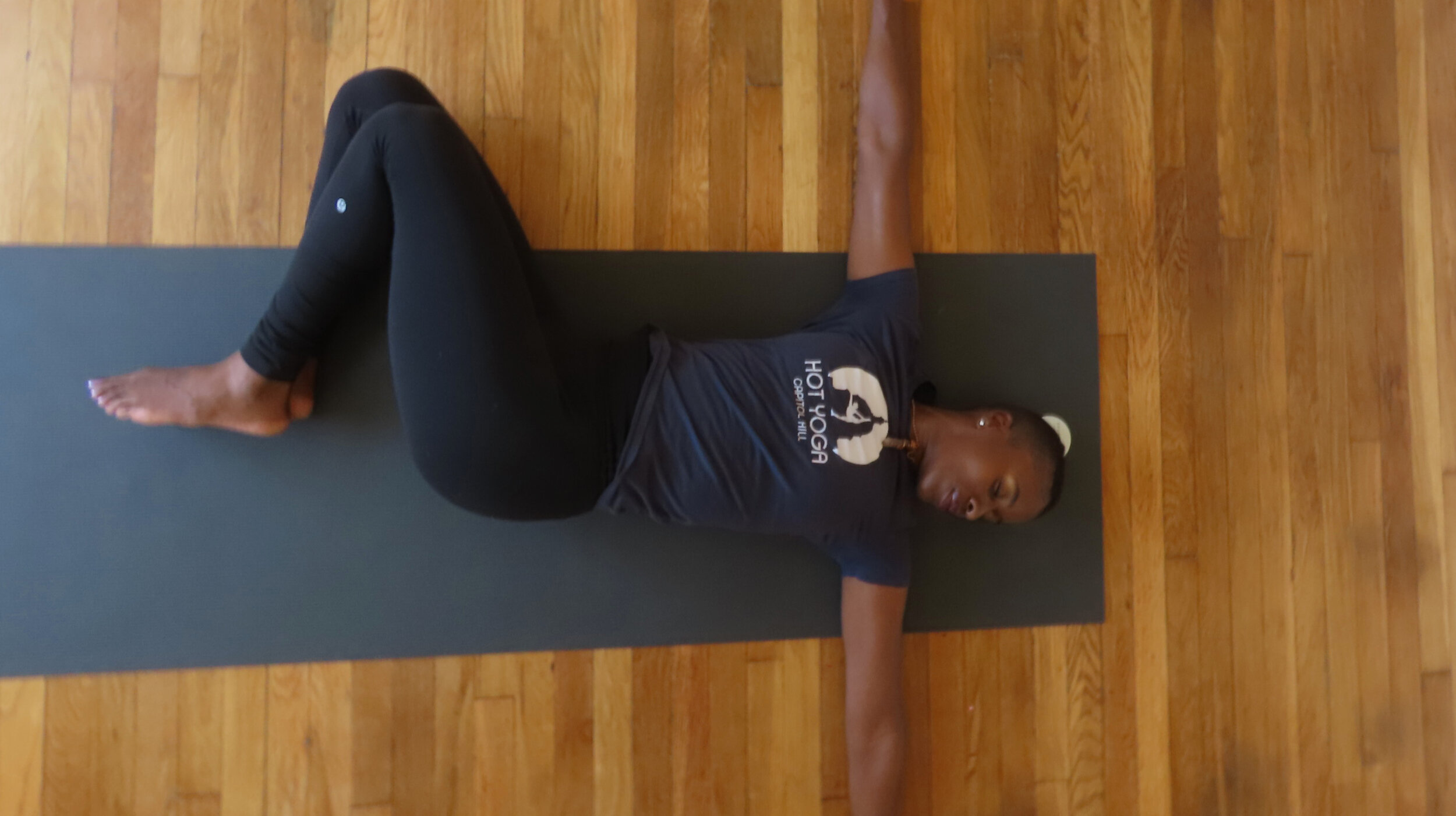Coping With COVID: A Yoga Sequence
The below text and yoga sequence were written and photographed by Lara Atella and LaShone Wilson.
When Julie, a former student at Hot Yoga Capitol Hill, reached out for help during her COVID (presumptive) recovery, Lara and LaShone knew it was time to put their research, ideas, and collaboration into action. Julie was one of several in the Capitol Hill area in Washington DC who Lara and Lashone knew were struggling and looking for support and relief. Julie and her husband Tom suggested a COVID recovery class, and Lara and LaShone agreed this was a great place to start. With all of their studio’s classes and programs now online, Lara and LaShone saw a perfect opportunity to meet in a safe, virtual environment to help people coping with recovery from COVID infection.
Hence, they began the “COPING with COVID” support team and online yoga class. In addition to feedback from Julie and others, Lara and LaShone tapped their own experience and connections working in research and clinical settings at institutions and hospitals and their knowledge of yoga. They concluded that the sequence would have to be adaptable, accessible, promote resilience, stress-reduction, and overall well-being. Lara and LaShone chose specific yoga postures and logical sequences that supported balance in the body's systems, emphasizing the respiratory, cardiovascular, and nervous systems most affected by COVID.
***
The sequence below is suggested yet should be modified when/if it does not provide comfort and support. The amount of time you spend in each posture can be shortened or lengthened depending on your energy level. Please take breaks as needed. The sequence can also be modified. More challenging postures are in bold and meant to be added over time as you continue to build endurance and strength.
For your set up, you do not need anything but yourself. A yoga mat is helpful. If you do not have a mat, you can just sit on the floor or on a blanket or towel. Find a comfortable spot, preferably one that is conducive for relaxation. If you have props, feel free to use them. We recommend that for this series you bring 2 bath/beach towels and keep them beside you for the supported postures.
Please consult with your doctor before doing this sequence or any form or exercise.
We begin the class with centering. It is a helpful way to slow the mind down, increase awareness, and connect to oneself by drawing your attention inward. Get comfortable and sit in Sukhasana (Easy Pose). Consider using the wall for back support. Allow yourself to relax here, perhaps closing your eyes and softening the throat. Connect with your breath for 1 to 3 minutes. Continue to allow the breath to flow freely as you move forward in your yoga series.
The next asana is Balasana (Child’s Pose). We recommend starting with knees wide and big toes touching. Arms can be stretched out in front of you or relaxed by your side. Stay here for up to about 60 seconds.
Stay in Child's Pose and slowly walk your hands to the right in an extended position, place the left hand on top of right. Hold for up to 30 seconds. Then slowly walk hands to the left and do the same, hold for up to 30 seconds.
If you have the energy, do a second set. Take your time. Then place your hands under the shoulders and slowly come down with legs extended in a prone position on your belly.
The next posture is Salabhasana (Locust Pose) with arms to the side behind you. Inhale breathing then both legs, arms and chest lift off the floor. If this is too much exertion, you can leave your chest down with the chin slightly forward and arms down. Another option is to lift one leg up at a time with the chest down. Also you may lift the chest up and keep the legs down. Do one or more of the variations with breaks as needed and head to side for 20 seconds between each set.
Gently roll to the side for a side Savasana. You can keep one arm under your head like a pillow. Stay here as long as you need it.
Next place your folded towel/towels under your chest for Matsyasana (Supported Fish Pose). Over time you may do Fish Pose without support. If dropping the head back is uncomfortable, try a supported savasana using the blanket/pillow to open the chest. Stay here for up to a minute opening your chest and accessing your lungs.
Roll to the side and then come up to a kneeling position for Marjaryasana (Cat Pose) and Bitilasana (Cow pose). In a table top position. Release the crown of your head toward the floor, but don't force your chin to your chest. Inhale, coming back into Cow Pose, and then exhale as you return to Cat Pose. Do this up to three times.
Sit on your heel with your feet together for Ardha Kurmasana (Half Tortoise Pose). Hips stay on heels or as close as possible and arms extend straight forward. Spine is lengthened. Arms are strong and off of the floor except for the knife edge of the baby fingers, palms together, thumbs crossed. If this is uncomfortable in the knees or hips come up slowly. Place a towel or two behind the knees, and consider trying again.
After sitting up, extend legs out in front of you and bring them together, with hands on the floor beside your hips for Dandasana (Staff Pose). Push hands into floor and lift chest to extend spine. Extend heels to straighten legs. Do 2 sets depending on energy level.
Scoot to the wall. With knees bent at a 90-degree angle, place your feet flat on the wall. If you feel strong enough push your feet firmly into the wall while keeping your knees bent. If you can do more bring one or both arms up extending towards the ceiling and parallel to your thighs. This is supine Utkatasana with wall support (Supine chair Pose). Stay here for up to 1 minute.
Supine Garudasana (Eagle Pose) with wall support is next. Right side then left side. Cross the right leg on top of the left, then the right arm under the left arm and place your hands on your shoulders. Keep the back and head on the floor, push your left foot into the wall and pull your elbows down towards your hips. Then reverse sides with a break between if needed. Do up to two sets.
Next is Viparita Karani—both legs up the wall. Your hips are close to the wall. Relax here as long as you'd like. This is a passive posture.
Release feet to floor and scoot away from the wall for Bandha Sarvangasana (Bridge Pose). Knees are bent and feet are flat on the floor just below the knees. Arms by your side. Lift the hips and thighs. If this is too much, gently bring your spine down vertebrae by vertebrae.
Our final active pose is a supine spine twist. Knees bent with arms out to side and release knees to right and look to the left. Try and keep the shoulders down. You can place a hand on the thigh for a deeper twist.
Then extend the legs forward and lie down on your back for your final Savasana (a resting pose) on your back. Savasana can be supported with blankets and/or a pillow.
We offer a free live Zoom class where you can receive instruction and take class with other COVID affected people on Fridays at 9:15am. Please email Lara and LaShone at hotyogacapitolhill@gmail.com to receive the class Zoom link.
***
LaShone Wilson is an Integrative Health and Wellness Coach, Yoga, and Mindful Living Teacher. She is the Director of One Breath at a Time Health and Wellness Services, and she manages and teaches at Hot Yoga Capitol Hill. She is professionally trained in behavioral change, evidence-based methodology, and social and emotional intelligence. The cumulative effect of her education, training, and complementary lifestyle empowers her with intimate knowledge and experience in effectively aiding others in reframing habit formed thoughts that no longer serve them. She hosts educational forums, workshops, and community events on self-care and conscious change. Because LaShone is an active participant in her well-being, she is able to partner with individuals in ways uncommon to many and resulting in effective lifestyle transformation.
Lara Atella is the Director and an instructor at Hot Yoga Capitol Hill—a DC-based yoga studio, training, and wellness center. Lara has consulted on and authored articles and other publications on topics related to yoga, wellness, and neurobehavioral science. Before running a yoga studio Lara worked at Johns Hopkins University and Hospital and the National Institutes of Health in neurobehavioral science. Her work and education have helped her to understand and appreciate yoga even more.




















